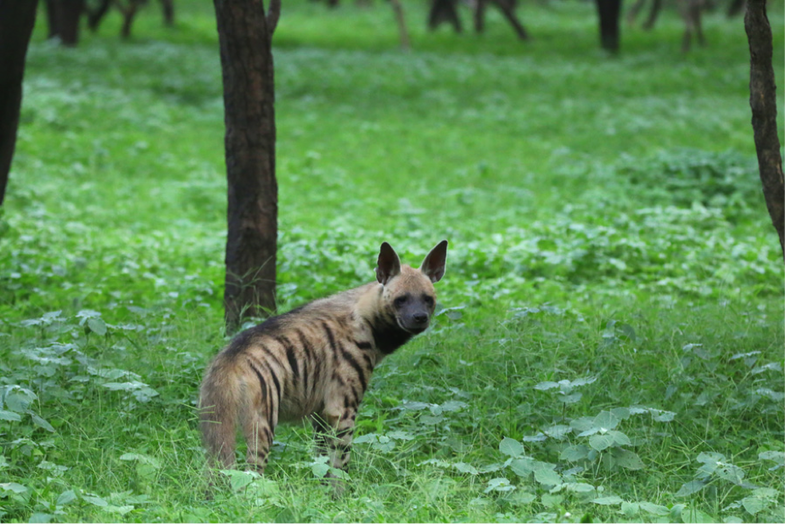|
Priyanka Das We visited the wildlife veterinary hospital of Sathyamangalam Tiger Reserve, Tamil Nadu, as part of our academic course work. There is a striped hyena undergoing treatment at the facility. The animal, which was resting when we first saw it, soon stood up and started moving in concentric circles for around five minutes. This abnormal behaviour took all of us by surprise and even scared us to some extent. Sometime towards the end of 2017, the striped hyena had entered into a village called Bijil Kuttai near Bhavanisagar, close to the Tiger Reserve. Although the animal had not harmed anyone or caused any kind of damage/loss, the villagers– out of fear and ignorance– had brutally beaten it up. The villagers then informed the Anti-Poaching Watchers (APW) staff and asked them to take the animal away, and threatened to kill it otherwise. Accompanied by the hospital veterinarian, when the APW staff reached the location, they found the animal almost half-dead, moaning in pain and badly infested with maggots. Upon detailed examination (performed on an off-day at a diagnostic centre meant for humans), the animal was found to have sustained severe injuries and multiple fractures; a missing canine, injuries to the head, shoulder joint dislocation, and a fracture in the vertebral bone, to name a few. The animal had also gone blind due a corneal condition, and it appeared to have been starving for a week before it was beaten up. Although the chances for its survival seemed bleak, Dr. K Asokan and his team were eventually successful in treating the hyena to better health. In the future, they plan to treat its corneal condition and translocate it to Vandalur zoo in Chennai. As the animal has been subjected to strong medication, nourished with cultivated meat, milk and bread, and is around eight years of age, they have wisely decided that it should not be released back into the wild. On the one hand, this is an incredible example of advancement in wildlife veterinary science in India, and shows how wildlife affected by anthropogenic activities can be saved. On the other hand, however, it makes one wonder about the ethical reasoning or morality in subjecting an animal to so much stress and pain, when it has to live a handicapped life in captivity. With the species’ population purpotedly dwindling, and its habitats being increasingly degraded by the spread of invasive Prosopis juliflora plants, this story perhaps adds to our collective understanding of the ‘Near Threatened’ striped hyena’s strained existence in one of its last remaining strongholds.
0 Comments
Soham Chakraborty To see a striped hyena in the wild is always a challenging task. Hyenas are nocturnal and highly elusive. In 2018, I was doing my research on dietary patterns of leopards in Jhalana Leopard Conservation Reserve, Rajasthan. Jhalana is India’s first leopard conservation reserve. With an area of around 30 sq. km, Jhalana is rich in biodiversity with a healthy population of leopards. Other than leopards, striped hyenas and desert foxes also thrive the reserve. Before commencing my research work I had visited this place a few times but wasn’t lucky enough to get the glimpse of a striped hyena. I started my research work from mid-May when the forest is dry and has greater visibility. On my very first day, after an excellent sighting of a leopard I had my first striped hyena sighting. I fall short of adjectives to describe that moment. The hyena was resting near a water hole, hardly bothered by the 3–4 gypsys around it. It was the first time that I was able to photo-document it. I had seen a hyena crossing the road in Rajaji National Park earlier that year. But that was during night time and I could not photograph the animal. After the first day’s sighting in Jhalana, hyena sightings became a regular event. A subsequent sighting which would be hard to forget was during the monsoons, when the forest becomes lush green with thick canopy. It is a little more difficult to spot animals during this season. Although leopard sightings were frequent, the same can’t be said in case of striped hyenas. After searching for nearly 2 hours in evening, we had hardly seen anything. There were no herbviore alarm calls to suggest presence of leopards. So I told my driver to wait near a water hole till dawn arrives. It was at this moment that I saw a gypsy standing 200 metres away from us and the tourists clicking pictures one after the other. Upon reaching the location I realised it was a hyena. The grey body with black stripes amidst a lush green background was simply amazing. It is probably the best sighting I have had of a hyena till date.
|


 RSS Feed
RSS Feed
